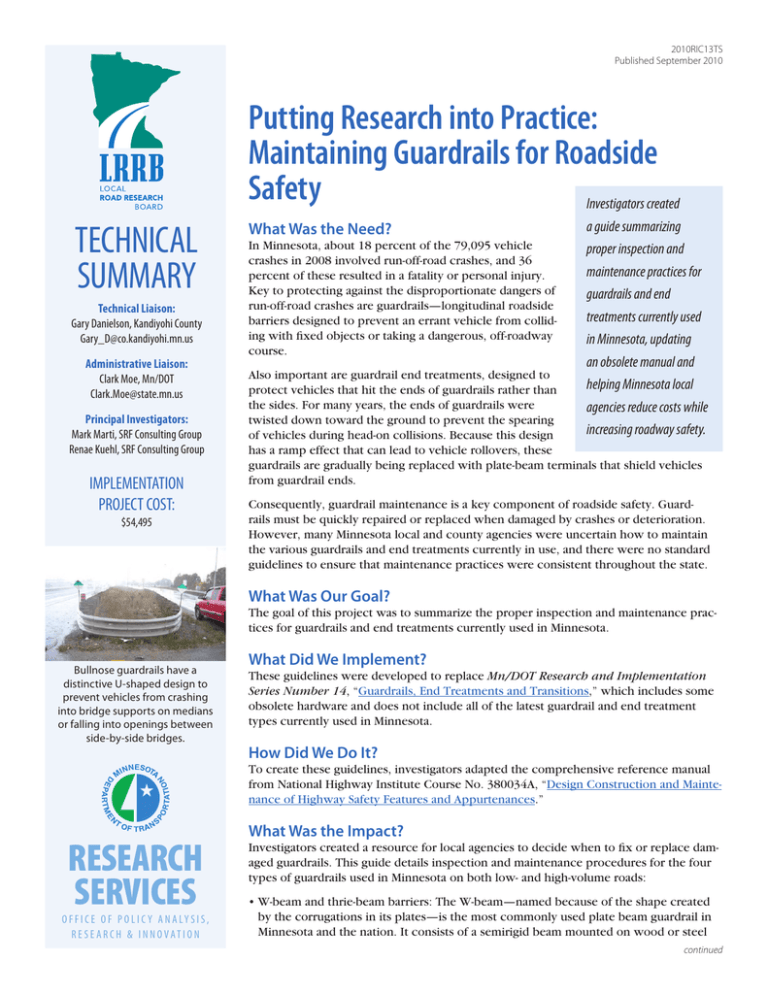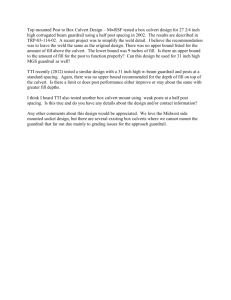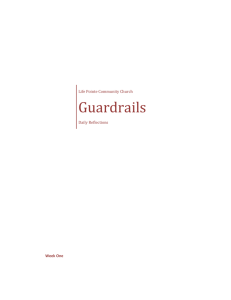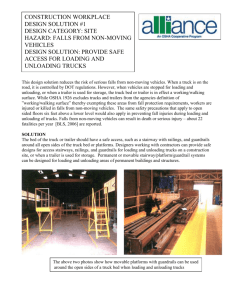TECHNICAL SUMMARY Putting Research into Practice: Maintaining Guardrails for Roadside
advertisement

2010RIC13TS Published September 2010 Putting Research into Practice: Maintaining Guardrails for Roadside Safety Investigators created TECHNICAL SUMMARY Technical Liaison: Gary Danielson, Kandiyohi County Gary_D@co.kandiyohi.mn.us Administrative Liaison: Clark Moe, Mn/DOT Clark.Moe@state.mn.us Principal Investigators: Mark Marti, SRF Consulting Group Renae Kuehl, SRF Consulting Group IMPLEMENTATION PROJECT COST: $54,495 What Was the Need? In Minnesota, about 18 percent of the 79,095 vehicle crashes in 2008 involved run-off-road crashes, and 36 percent of these resulted in a fatality or personal injury. Key to protecting against the disproportionate dangers of run-off-road crashes are guardrails—longitudinal roadside barriers designed to prevent an errant vehicle from colliding with fixed objects or taking a dangerous, off-roadway course. a guide summarizing proper inspection and maintenance practices for guardrails and end treatments currently used in Minnesota, updating an obsolete manual and helping Minnesota local agencies reduce costs while increasing roadway safety. Also important are guardrail end treatments, designed to protect vehicles that hit the ends of guardrails rather than the sides. For many years, the ends of guardrails were twisted down toward the ground to prevent the spearing of vehicles during head-on collisions. Because this design has a ramp effect that can lead to vehicle rollovers, these guardrails are gradually being replaced with plate-beam terminals that shield vehicles from guardrail ends. Consequently, guardrail maintenance is a key component of roadside safety. Guardrails must be quickly repaired or replaced when damaged by crashes or deterioration. However, many Minnesota local and county agencies were uncertain how to maintain the various guardrails and end treatments currently in use, and there were no standard guidelines to ensure that maintenance practices were consistent throughout the state. What Was Our Goal? The goal of this project was to summarize the proper inspection and maintenance practices for guardrails and end treatments currently used in Minnesota. Bullnose guardrails have a distinctive U-shaped design to prevent vehicles from crashing into bridge supports on medians or falling into openings between side-by-side bridges. What Did We Implement? These guidelines were developed to replace Mn/DOT Research and Implementation Series Number 14, “Guardrails, End Treatments and Transitions,” which includes some obsolete hardware and does not include all of the latest guardrail and end treatment types currently used in Minnesota. How Did We Do It? To create these guidelines, investigators adapted the comprehensive reference manual from National Highway Institute Course No. 380034A, “Design Construction and Maintenance of Highway Safety Features and Appurtenances.” RESEARCH SERVICES O F F I C E O F P O L I C Y A N A LY S I S , R E SE A R C H & I N N OVAT I O N What Was the Impact? Investigators created a resource for local agencies to decide when to fix or replace damaged guardrails. This guide details inspection and maintenance procedures for the four types of guardrails used in Minnesota on both low- and high-volume roads: • W-beam and thrie-beam barriers: The W-beam—named because of the shape created by the corrugations in its plates—is the most commonly used plate beam guardrail in Minnesota and the nation. It consists of a semirigid beam mounted on wood or steel continued “This guide will contribute to saving lives by helping agencies keep guardrails in repair and will save costs by encouraging maintenance practices that allow guardrails to be replaced less frequently.” –Renae Kuehl, SRF Consulting Group “This guide will be an excellent quick reference for county engineers, among whom there are significant differences in knowledge and expertise concerning guardrail replacement and maintenance.” –Gary Danielson, Kandiyohi County Engineer The SRT-350 slotted rail terminal is one of seven end treatments currently used in Minnesota and is designed to prevent spearing during a head-on collision by deflecting the vehicle behind the guardrail. This system provides an easy upgrade on obsolete installations. posts, and bends to resist the impact of vehicles while limiting lateral deflection. The thrie-beam is a stronger and wider version of the W-beam, with one additional corrugation in its plates. • Cable barriers: This system is composed of cables held by weak wood or steel posts, and designed as an inexpensive way to capture or redirect errant vehicles before they cross medians into oncoming traffic. • Bullnose rail systems: Bullnose rail systems consist of a thrie-beam guardrail modified for use at bridge overpasses and underpasses, using curved sections to protect vehicles from either crashing into bridge supports or falling into the opening between side-byside bridges. • Concrete barriers: These barriers are used on high-speed roadways in locations where little or no deflection can be tolerated, such as medians, bridge rails and bridge supports. For each of these barriers, the report details procedures for: • Basic inspection, conducted periodically to ensure that barriers are not significantly damaged. • In-depth inspection, carried out when roadways are reconstructed or extensively repaired to determine whether guardrails are compatible with the new road design, existing traffic conditions and the latest guardrail standards, or should be upgraded to improve safety. • Routine maintenance, including occasionally replacing or adjusting parts. • Crash-related maintenance, performed to repair crash damage. In the case of severe damage, barriers should be upgraded to the latest standards. The guide also describes maintenance procedures for the seven guardrail end treatments currently used in Minnesota and includes links to resources and standards for decision support and installation of roadside protection devices as well as a one-page quick-reference guide to each guardrail and end treatment type. What’s Next? Produced by CTC & Associates for: Minnesota Department of Transportation Research Services Section MS 330, First Floor 395 John Ireland Blvd. St. Paul, MN 55155-1899 (651) 366-3780 www.research.dot.state.mn.us This guide will be available to county agencies via the Web and includes access to the extensive manual for the National Highway Institute course on which it is based. By eliminating uncertainty among county and local agencies about the maintenance of a critical roadside safety feature, the guide is a key component of Minnesota’s Toward Zero Deaths campaign, which seeks to create a culture that helps eliminate traffic fatalities and serious injuries. This Technical Summary pertains to the LRRB-produced implementation product 2010RIC13, “Guardrail Replacement and Maintenance Guidelines,” published March 2010. This guide can be accessed at http://www.lrrb.org/PDF/2010RIC13.pdf. The research being implemented via this project can be found mainly in Mn/DOT Research and Implementation Series Number 14, “Guardrails, End Treatments and Transitions,” published August 1993, and available at http://www.ctre.iastate.edu/mndot_ors/detail.cfm?productID=110.





